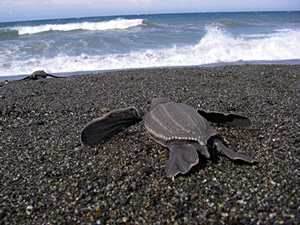|
For Immediate Release, February 26, 2013
Scientists Predict Extinction in 20 Years for Pacific Leatherback Sea Turtles; SAN FRANCISCO— A new study finds that the Western Pacific population of leatherback sea turtles, which includes the leatherbacks that feed in West Coast waters, has continued to decline since the 1980s. If these trends continue, extinction may be inevitable in 20 years because the number of turtles will be so low, predicted Thane Wibbels, a professor at the University of Alabama and member of a research team that conducted the research. This population represents the last remaining stronghold of leatherbacks in the Pacific Ocean.
The study was published today in the Ecological Society of America's online scientific journal Ecosphere and included scientists from State University of Papua, the National Oceanic and Atmospheric Administration, National Marine Fisheries Service and the World Wildlife Fund Indonesia. “This study is a grim warning that we’re not doing enough to save leatherback sea turtles or their ocean home. The problems they face — climate change, plastic pollution, fisheries that catch far more than fish — are problems that threaten us, too. We need to act now to stop these amazing, ancient animals from winking out forever,” said Catherine Kilduff with the Center for Biological Diversity. The study found that, since 1984, nesting sea turtles have declined 5.9 percent per year at the last large nesting site in the entire Pacific — Bird’s Head Peninsula, Papua Barat, Indonesia. At Jamursba Medi Beach — one of the sites on Bird’s Head Peninsula that accounts for 75 percent of total leatherback nesting in the western Pacific — nests have fallen from a peak of 14,455 in 1984 to a low of 1,532 in 2011. Given that each female nests multiple times each year, the study estimates approximately 500 leatherbacks now nest at Bird’s Head annually. “This new study confirms that we should be doing everything possible to protect leatherback sea turtles both in our waters and abroad. In contrast, the National Marine Fisheries Service is actively proposing the expansion of deadly driftnets into leatherback sea turtle critical habitat and the ‘Pacific Leatherback Conservation Area’ off of California and Oregon,” said Ben Enticknap, Pacific campaign manager and senior scientist with Oceana. "Leatherbacks are in big trouble and every one that drowns in a gillnet or on a longline hook is a major casualty," said Teri Shore, program director at Turtle Island Restoration Network. "Allowing more sea turtles to be entangled by California's swordfish fleet in protected sea turtle habitat would be a tragedy for this vulnerable sea turtle." Threats to the sea turtles include catch in fisheries, predation of eggs and hatchlings by pigs and dogs, beach erosion, elevated sand temperatures at nesting sites and climate-driven oceanographic processes. The scientists concluded that beach conservation alone will not be enough to prevent extinction; they urged additional conservation measures in national and international waters to reverse the decline. Leatherback sea turtles are the largest sea turtles on the planet. Some of these turtles, weighing between 550 and 2,000 pounds with lengths of up to six feet, migrate across the Pacific Ocean to feed in waters off the U.S. coast. Leatherback sea turtles have been protected under the Endangered Species Act since 1970, but without protected “critical” habitat. In February 2012 the United States finally protected that critical habitat for them — more than 40,000 square miles of coastal waters off Washington, Oregon and California, where leatherbacks feed on jellyfish. Pacific leatherbacks were designated as California’s official state marine reptile symbol in 2012. The Center for Biological Diversity is a national, nonprofit conservation organization with more than 450,000 members and online activists dedicated to the protection of endangered species and wild places. Oceana is the largest international advocacy group working solely to protect the world’s oceans. Oceana wins policy victories for the oceans using science-based campaigns. Since 2001, we have protected over 1.2 million square miles of ocean and innumerable sea turtles, sharks, dolphins and other sea creatures. More than 550,000 supporters have already joined Oceana. Global in scope, Oceana has offices in North, South and Central America and Europe. www.oceana.org Turtle Island Restoration Network (SeaTurtles.org) is an international marine conservation organization headquartered in California whose 60,000 members and online activists work to protect sea turtles and marine biodiversity in the United States and around the world. www.SeaTurtles.org |


